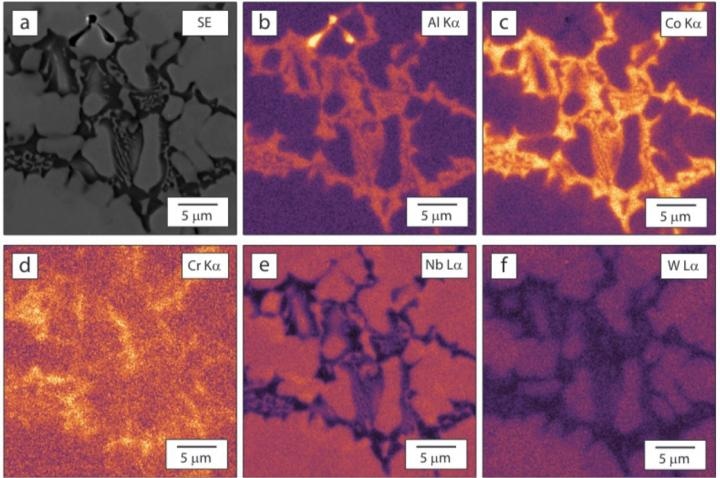Sep 6 2019
A new technique to discover materials using electron microscopy and data analytics has exposed a new group of very hard alloys. Such materials could possibly endure extreme impact from projectiles, thus providing improved protection for combat soldiers. Scientists from Lehigh University describe the technique and findings in an article, "Materials Informatics for the Screening of Multi-Principal Elements and High-Entropy Alloys," that has been published recently in Nature Communications.
 An X-ray energy-dispersive spectroscopy (EDS) map of the as-cast microstructure of a hard alloy predicted from Lehigh University researchers' analysis. Lettered panels are X-ray intensity maps associated with different elements comprising the alloy that permit deduction of the spatial distributions of these elements. (Image credit: Lehigh University)
An X-ray energy-dispersive spectroscopy (EDS) map of the as-cast microstructure of a hard alloy predicted from Lehigh University researchers' analysis. Lettered panels are X-ray intensity maps associated with different elements comprising the alloy that permit deduction of the spatial distributions of these elements. (Image credit: Lehigh University)
"We used materials informatics — the application of the methods of data science to materials problems - to predict a class of materials that have superior mechanical properties," said main author Jeffrey M. Rickman, professor of materials science and engineering and physics and Class of '61 Professor at Lehigh University.
Scientists also used experimental instruments, such as electron microscopy, to get an understanding of the physical mechanisms that resulted in the observed behavior in the class of materials called high-entropy alloys (HEAs). HEAs contain a number of various elements that, when blended, may give rise to systems having advantageous and sometimes unanticipated mechanical and thermal properties. For that reason, they are presently the topic of passionate research.
"We thought that the techniques that we have developed would be useful in identifying promising HEAs," Rickman said. "However, we found alloys that had hardness values that exceeded our initial expectations. Their hardness values are about a factor of 2 better than other, more typical high-entropy alloys and other relatively hard binary alloys."
The seven authors involved in the research are a part of Lehigh University, including Rickman; Helen M. Chan, New Jersey Zinc Professor of materials science and engineering; Martin P. Harmer, Alcoa Foundation Professor of materials science and engineering; Joshua Smeltzer, graduate student in materials science and engineering; Christopher Marvel, postdoctoral research associate in materials science and engineering; Ankit Roy, graduate student in mechanical engineering and mechanics; and Ganesh Balasubramanian, assistant professor of mechanical engineering and mechanics.
Rise of High-Entropy Alloys and Data Analysis
The field of high-entropy, or multi-principal element, alloys has recently witnessed rapid growth. These systems signify a paradigm change in alloy development, as some display new structures and better mechanical properties, as well as improved magnetic properties and oxidation resistance, compared with conventional alloys. However, identifying prospective HEAs has presented a tough challenge, given the huge palette of potential elements and combinations that could be present.
Scientists have found a way to recognize the element combinations and compositions that produced high-hardness, high-strength alloys and other necessary qualities, which are a comparatively small subset of the large number of prospective HSAs that could be developed.
Lately, materials informatics, the application of data science to issues in materials science and engineering, has arisen as a robust tool for the discovery and design of materials. The relatively new field is already having an important effect on the analysis of data for a range of materials systems, including those used in thermoelectrics, hydrogen storage materials, battery anodes and cathodes, ferroelectrics, and polymer dielectrics.
"Creation of large data sets in materials science, in particular, is transforming the way research is done in the field by providing opportunities to identify complex relationships and to extract information that will enable new discoveries and catalyze materials design," Rickman said. The instruments of data science, including multivariate statistics, dimensional reduction, machine learning, and data visualization, have already resulted in the identification of structure-property-processing relationships, screening of potential alloys, and correlation of microstructure with processing factors.
Lehigh University's study adds to the field of materials informatics by showing that this collection of tools is very useful for ascertaining favorable materials from among innumerable possibilities. "These tools can be used in a variety of contexts to narrow large experimental parameter spaces to accelerate the search for new materials," Rickman said.
New Method Combines Complementary Tools
Lehigh University scientists integrated two complementary tools to apply a controlled learning strategy for the efficient screening of high-entropy alloys and to detect promising HEAs: (1) a canonical-correlation analysis and (2) a genetic algorithm with a canonical-correlation analysis-inspired fitness function.
They executed this process using a database for which mechanical property data is available and showcasing new alloys with high hardness levels. The methodology was checked by comparing predicted hardness with alloys made in a laboratory using arc-melting, detecting alloys with very high levels of hardness.
The methods employed here involved a novel combination of existing methods adapted to the high-entropy alloy problem. In addition, these methods may be generalized to discover, for example, alloys having other desirable properties. We believe that our approach, which relies on data science and experimental characterization, has the potential to change the way researchers discover such systems going forward.
Jeffrey M. Rickman, Professor of Materials Science and Engineering and Physics, Lehigh University